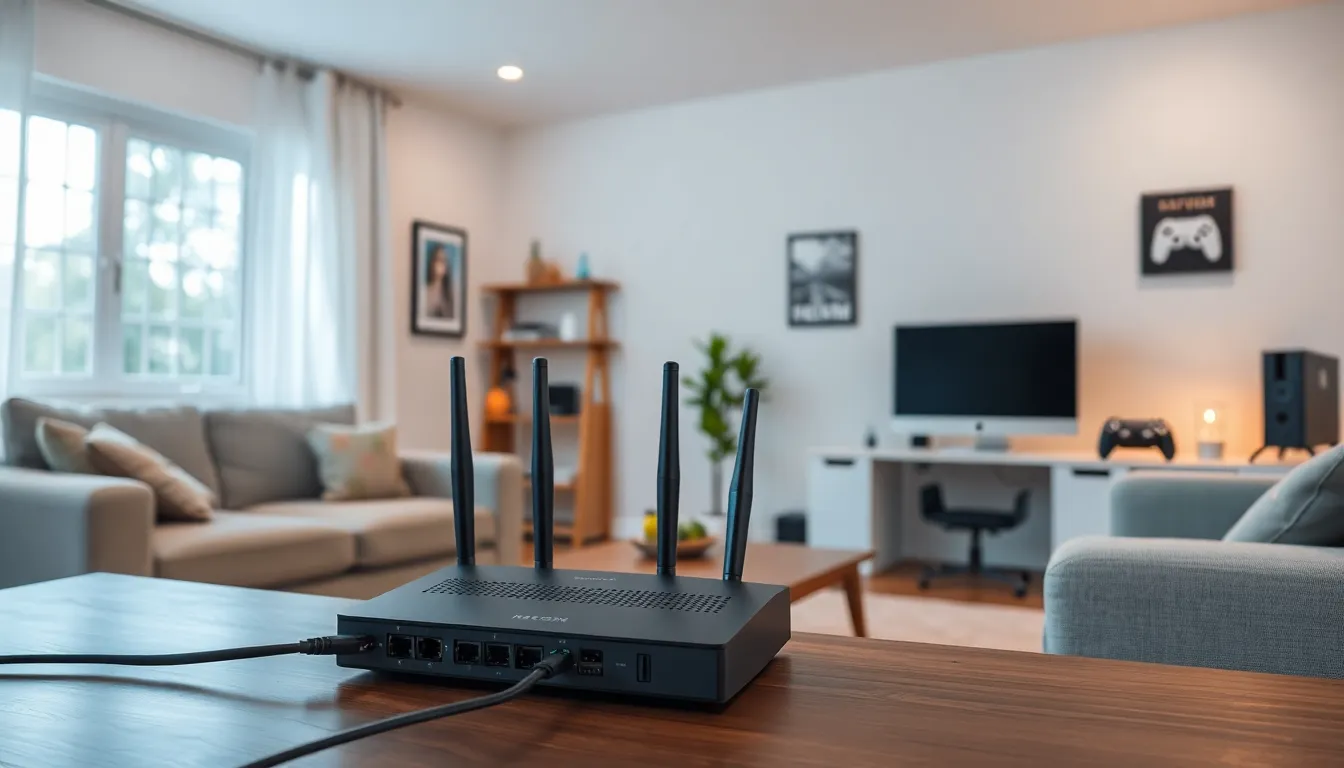Table of Contents
ToggleIn today’s digital jungle, a reliable home network isn’t just a luxury—it’s a necessity. Whether it’s streaming that binge-worthy series or video chatting with Grandma, a solid connection can make or break the experience. But let’s face it, setting up a home network can feel like trying to solve a Rubik’s Cube blindfolded.
Fear not! With the right home networking solutions, you’ll navigate this tangled web with ease. Imagine zipping through your online activities without the dreaded buffering wheel haunting your dreams. From Wi-Fi extenders to mesh systems, there’s a solution for every home. Get ready to turn your Wi-Fi woes into a thing of the past, and keep your devices happy and connected.
Overview of Home Networking Solutions
Home networking solutions provide essential connectivity to various devices. Wireless routers serve as the primary gateway, allowing computers, smartphones, and smart home devices to access the internet. Selecting the right router depends on several factors, including size, speed, and coverage area.
Wi-Fi extenders boost signal strength, addressing connectivity issues in larger homes. These devices amplify the existing Wi-Fi signal, ensuring devices in distant rooms receive good coverage. Mesh systems offer a more comprehensive solution, using multiple nodes to create a unified network, eliminating dead zones.
Powerline adapters utilize existing electrical wiring to extend the network. By enabling data transfer through the home’s power lines, they provide wired-like speeds in areas where Wi-Fi signals struggle. This solution is particularly useful for basements or areas far from the router.
Network switches expand the wired connections available in a home. This device connects multiple Ethernet cables, allowing more devices to have direct internet access. Gamers and professionals often prefer a direct connection due to its reliability.
Security is a crucial consideration for home networks. Implementing strong passwords and enabling network encryption helps safeguard sensitive information. Regular software updates for routers and connected devices also enhance security, mitigating potential vulnerabilities.
Various home networking solutions exist designed to meet different needs. Choosing the right combination of devices ensures optimal coverage, reliability, and security for all connected devices. With the correct setup, achieving seamless connectivity throughout the home becomes attainable.
Types of Home Networking Solutions

Various home networking solutions enhance connectivity and improve digital experiences. Understanding these options helps in selecting the best fit for individual needs.
Wired Networking
Wired networking utilizes physical cables to establish direct connections between devices. Ethernet cables offer high-speed data transfer, making them ideal for gaming consoles, desktop computers, and streaming devices. Stability remains a significant advantage, as wired connections minimize latency and buffering. Network switches expand available ports, allowing multiple devices to connect seamlessly. Powerline adapters provide flexibility by leveraging existing electrical wiring, perfect for hard-to-reach areas. Overall, wired networking solutions deliver reliability and performance essential for demanding tasks.
Wireless Networking
Wireless networking employs radio waves to connect devices without cables, offering convenience and mobility. Wi-Fi routers serve as the central hub, allowing smartphones, tablets, and laptops to access the internet anywhere in the home. Mesh systems eliminate dead zones by using multiple nodes to extend coverage and create a unified network. Wi-Fi extenders boost signals, improving connectivity in larger homes. Security protocols like WPA3 protect networks against unauthorized access, ensuring a safe online environment. Wireless solutions provide the flexibility and coverage necessary for modern households.
Factors to Consider When Choosing Solutions
Choosing the right home networking solution requires careful consideration of several factors that impact connectivity and overall performance.
Speed and Performance
Speed directly affects online activities, such as streaming 4K videos or engaging in video calls. Look for routers with high Mbps ratings, typically ranging from 200 Mbps to over 1 Gbps. Performance varies among devices, with dual-band and tri-band routers offering better speeds and performance in congested environments. Evaluation of latency is also essential for online gaming; lower latency ensures smoother connections. Prioritizing models that optimize performance based on device usage is crucial, ensuring efficient internet access for multiple users and devices.
Coverage and Range
Coverage determines how far the internet signal reaches in a home. Larger homes often require solutions like mesh systems or Wi-Fi extenders to eliminate dead zones. Mesh networks create seamless coverage by using multiple nodes that communicate with each other, while extenders increase signal strength in specific areas. Check the square footage that routers can cover, with effective models usually ranging from 1,500 to 5,000 square feet. Proper planning of router placement enhances range effectively, maximizing coverage throughout the home.
Budget and Cost
Costs vary significantly among networking solutions, from budget-friendly options to high-end devices. Budget considerations typically range from $50 for basic routers to several hundred dollars for advanced mesh systems. Assessing long-term value is essential; investing in reliable equipment prevents frequent replacements and provides better service. Consider ongoing costs, including additional accessories or subscriptions for advanced features. Balancing needs with a budget helps select the most effective solution without overspending.
Setting Up Your Home Network
Setting up a home network involves selecting essential equipment and following configuration steps for optimal performance.
Equipment Needed
Wireless routers represent the core component for internet access. Choose one based on size, speed, and coverage area. Wi-Fi extenders and mesh systems enhance connectivity by expanding coverage into larger homes. Powerline adapters utilize existing electrical wiring to extend internet access where Wi-Fi signals struggle. Network switches allow for multiple wired connections, providing stable links favored by gamers and professionals. All these devices work together to create a seamless network.
Configuration Steps
Begin by placing the router in a central location for maximum coverage. Connect it to the modem using an Ethernet cable. Next, configure the router’s settings through its web interface. Change the default username and password to enhance security. Set up the Wi-Fi network name and password, ensuring strong encryption is enabled. If using extenders or mesh systems, follow their specific setup instructions for seamless integration. Finally, update the router’s firmware regularly to maintain security and performance.
A reliable home network is essential for navigating today’s digital landscape. By selecting the right combination of networking solutions, individuals can enhance their online experience significantly. Whether opting for Wi-Fi extenders, mesh systems, or wired connections, the goal is to ensure seamless connectivity throughout the home.
Following the outlined setup steps can simplify the process of establishing a robust network. With careful consideration of factors like speed, coverage, and budget, anyone can create a network that meets their specific needs. Prioritizing security measures further safeguards personal information, making the home network not only efficient but also secure. Embracing these solutions paves the way for a smooth and enjoyable online experience.







